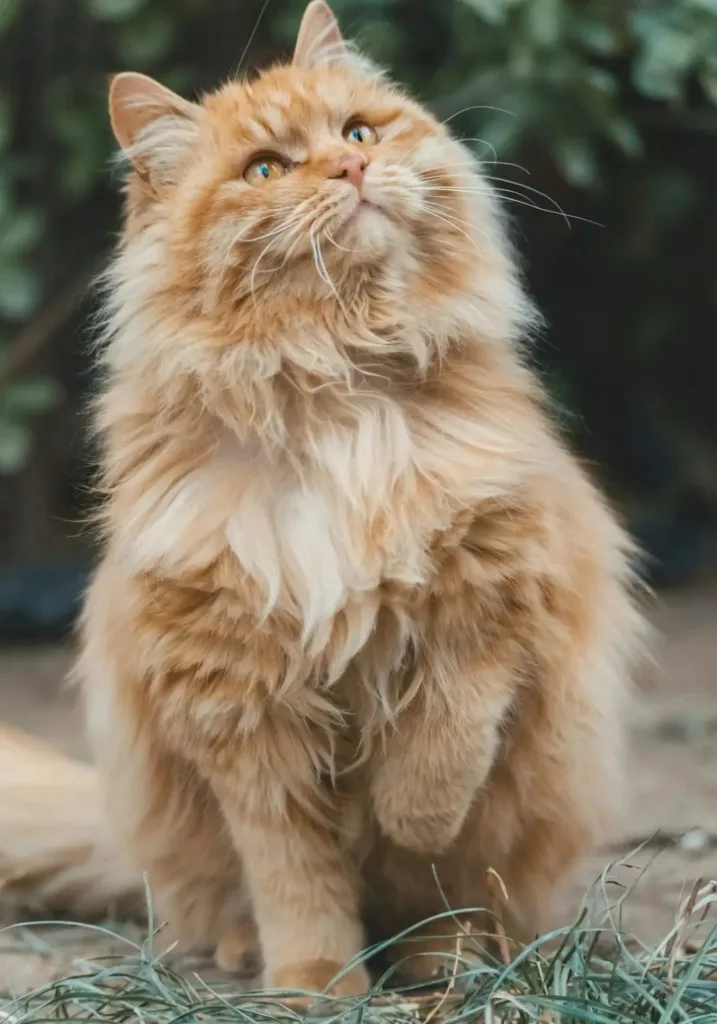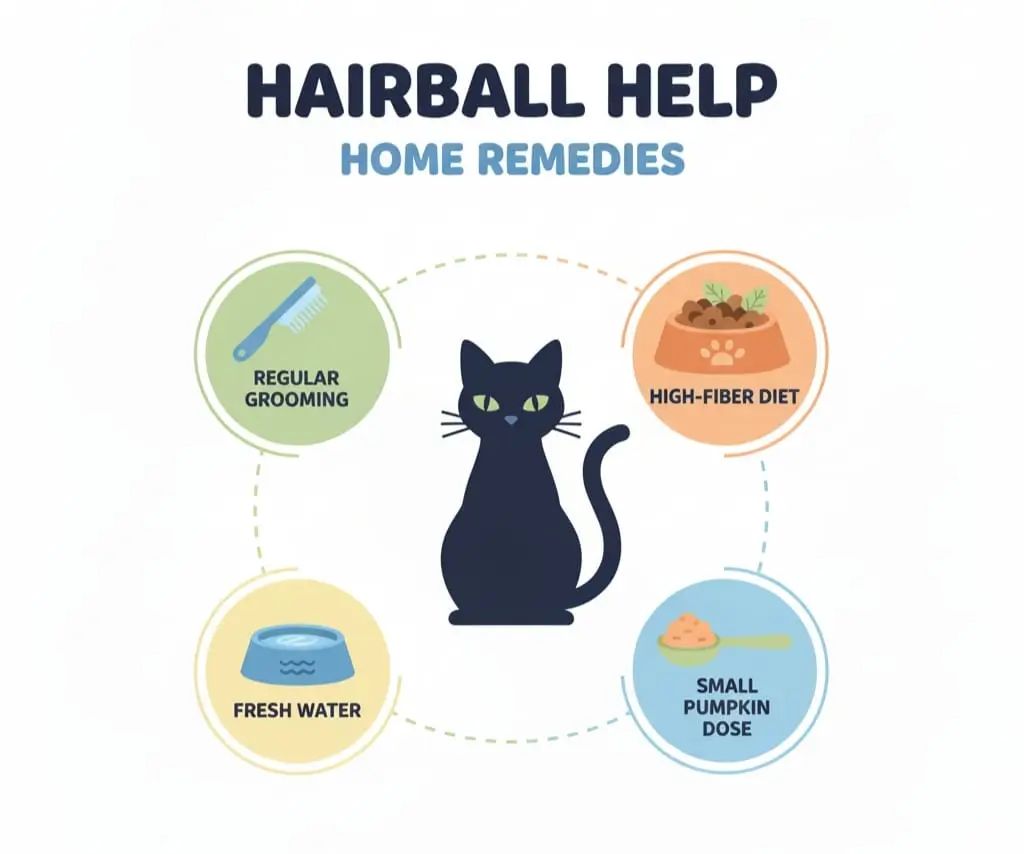If your cat is constantly hacking, gagging, or leaving behind unpleasant hair clumps, you may be searching for an effective cat hairball remedy. Hairballs, also called trichobezoars, are a common issue in cats of all breeds, especially long-haired ones. While an occasional hairball can be normal, frequent or difficult episodes may signal deeper health problems. In this complete guide, we’ll cover everything cat parents need to know: the causes of hairballs in cats, early symptoms to watch for, veterinary treatments, safe home remedies for hairballs, and long-term hairball prevention tips. Whether you’re dealing with a Maine Coon, Persian, or short-haired cat, these proven strategies will help you manage hairballs naturally and keep your feline healthy, comfortable, and hairball-free.
What Are Hairballs?
Hairballs, or trichobezoars, are clumps of ingested fur that cats regurgitate when grooming-related hair accumulates in the stomach. Composed primarily of indigestible keratin (the protein in hair), these masses combine with mucus, bile, and digestive fluids, forming a compact structure that’s typically expelled through vomiting. In healthy cats, much of the ingested hair passes unnoticed in feces, but excessive accumulation can overwhelm the digestive system. A common misconception is that all cats frequently get hairballs—kittens and short-haired breeds often have fewer due to less intense grooming. Persistent hairballs may signal underlying health issues, filling a content gap about their connection to systemic conditions.
What Does a Cat Hairball Look Like?
A cat hairball typically appears as a slender, cigar-shaped tube, molded by the esophagus during regurgitation, measuring 2-5 inches long and about an inch wide. Freshly expelled, it’s moist, slimy, and matches the cat’s fur color, often tinged with yellow bile or food remnants, with a mild, sour odor. Dried hairballs resemble fuzzy, compact logs. Unlike feces, which are passed rectally, hairballs are vomited orally and lack a strong fecal smell. A content gap is mistaking blockages with foreign objects (e.g., string) for simple hairballs, which can delay critical treatment.
What Causes Hairballs in Cats?

Hairballs in cats result from grooming but are influenced by multiple factors that increase fur ingestion or hinder its passage.
Excessive Grooming
Cats spend up to 50% of their waking hours grooming, using barbed tongues (papillae) to trap loose hair, swallowing significant amounts daily. Overgrooming due to stress, boredom, or skin irritation (e.g., fleas, allergies) amplifies intake, especially in multi-pet homes where competition or anxiety triggers compulsive behavior—a psychological factor often under-discussed.
Seasonal Shedding
Cats shed heavily in spring and fall, increasing loose fur that’s ingested. Indoor cats exposed to artificial lighting may shed continuously, while dry indoor air from heating exacerbates fur loss, a seasonal nuance rarely highlighted.
Breed-Specific Risks
Long-haired breeds like Persians, Maine Coons, Ragdolls, and Himalayans ingest more voluminous fur, making them 2-3 times more prone to hairballs than short-haired breeds like Siamese. However, dense undercoats in breeds like Siberians also pose risks, debunking the myth that only longhairs are affected.
Health Conditions
Gastrointestinal issues like inflammatory bowel disease (IBD), megacolon, or tumors slow digestion, trapping hair. Skin conditions (allergies, mites), endocrine disorders (hyperthyroidism, diabetes), or pain from arthritis prompt excessive licking. Urinary infections may cause abdominal grooming, increasing fur intake—a holistic view filling gaps in non-digestive causes.
Dietary and Hydration Issues
Low-fiber diets impede hair passage, while dehydration thickens digestive contents, promoting clumping. Senior cats with reduced kidney function or those on dry kibble-only diets face higher risks, especially if water intake is low.
Why Is My Cat Getting Hairballs?
If your cat produces hairballs more than once or twice monthly, consider age (older cats groom more efficiently), lifestyle (indoor cats may overgroom from boredom), or environmental changes (new pets, moves). Sudden increases may indicate allergies, stress, or ingestion of non-fur objects like string, a content gap in recognizing external triggers in multi-cat or cluttered homes.
Recognizing Symptoms of Hairballs in Cats
Identifying hairball symptoms in cats early prevents complications, but distinguishing them from other vomiting causes is critical.
- Retching and Hacking: Cats exhibit arched backs, extended necks, and guttural hacking noises as they contract abdominal muscles to expel a hairball, typically lasting 1-2 minutes. This regurgitation is often mistaken for coughing, but it originates in the stomach, not lungs.
- Vomiting or Gagging: Successful vomiting produces a hairball with clear or bile-tinged fluid; unsuccessful gagging suggests a potential blockage. Chronic vomiting with food or mucus indicates delayed gastric emptying.
- Appetite Loss and Lethargy: Partial blockages cause nausea, reduced eating, and withdrawal—cats may hide or appear depressed, a behavioral sign often missed. Gradual weight loss signals systemic issues.
- Constipation or Diarrhea: Hair in the intestines can cause straining, small/hard stools, or loose stools from irritation. Abdominal bloating or tenderness (guarding) is a serious warning.
- Behavioral Changes: Increased vocalization, restlessness before vomiting, or overgrooming bald spots from discomfort. Fever may indicate secondary infections like abscesses from blockages.
Do Cats Make Noises When They Have a Hairball?
Yes, cats produce distinct sounds during hairball expulsion, including hacking coughs, gagging retches, or cries/howls from esophageal irritation. These differ from silent or wheezing respiratory coughs (e.g., asthma), a critical diagnostic distinction to avoid misdiagnosis.
What if My Cat Is Trying to Cough up a Hairball but Can’t?
Repeated unproductive retching (3+ times daily) without expelling a hairball signals a potential obstruction, requiring urgent veterinary care. Symptoms like bile vomiting, dehydration, or collapse indicate emergencies; delays risk intestinal perforation, debunking the myth that persistent efforts are harmless.
How Vets Diagnose and Treat Hairballs in Cats
Veterinary intervention is crucial for frequent or severe cases. Diagnosis of Hairballs in Cats include:
- Medical History and Physical Exam: Vets assess grooming habits, diet, frequency of episodes, and recent stressors; abdominal palpation detects masses, pain, or bloating. Skin exams check for parasites or allergies triggering overgrooming.
- Bloodwork and Urinalysis: Complete blood count (CBC), chemistry panels, and urine tests evaluate organ function, dehydration, or infections like IBD. Fecal analysis rules out parasites like worms that mimic symptoms.
- Imaging Techniques: X-rays reveal dense hairball masses; ultrasounds assess gut motility and organ health; contrast studies pinpoint blockages. Endoscopy provides direct visualization and biopsy options.
- Specialized Testing: Skin cytology, ringworm cultures, or hypoallergenic diet trials identify allergy triggers; behavioral assessments address stress-related grooming. Costs range from $200-800 based on test complexity.
Treating Hairballs in Cats
- Lubricants and Laxatives: Petroleum-based gels (e.g., Laxatone, 1-2 tsp 2-3x weekly) lubricate the GI tract for easier passage; avoid human laxatives or oils like butter, which risk aspiration pneumonia.
- Dietary Interventions: High-fiber diets (e.g., Royal Canin Hairball Care) or supplements like psyllium enhance motility; add canned pumpkin (1 tsp daily) for natural fiber. Wet food increases hydration.
- Medications for Underlying Issues: Anti-inflammatories for IBD, antihistamines for allergies, or analgesics for arthritis reduce grooming triggers. Pheromone therapy addresses stress.
- Surgical or Endoscopic Removal: Endoscopy retrieves stomach hairballs; surgery ($1,500-3,000) addresses intestinal blockages, with post-op IV fluids and monitoring for 1-3 days.
Are There Home Remedies for Cat Hairballs?

Yes, vet-approved home remedies for cat hairballs can effectively manage mild cases, reducing reliance on commercial products while ensuring safety. Below are subpoints detailing practical, safe options, addressing the content gap of balancing efficacy with caution to avoid harmful DIY approaches.
- Coconut Oil: A small dab (1/4 tsp daily, max 1/2 tsp for large cats) lubricates the digestive tract, easing hair passage. Use virgin, unrefined coconut oil, mixing it into food to prevent choking. Start with tiny amounts to avoid diarrhea, and consult a vet for cats with pancreatitis or fat-sensitive conditions, as overuse can cause loose stools or weight gain.
- Canned Pumpkin: Rich in fiber, pureed pumpkin (1/2-1 tsp daily, no added sugar) promotes intestinal motility and softens stools, helping hair pass naturally. Ensure it’s plain pumpkin, not pie filling, and monitor for digestive upset. Its palatability makes it a favorite, but gradual introduction prevents rejection.
- Cat Grass or Safe Greens: Offering wheatgrass or oat grass encourages natural vomiting or adds fiber to aid digestion. Grown indoors, it’s a safe, chemical-free option, but limit intake to avoid excessive vomiting. Avoid toxic plants like lilies, a precaution often omitted in guides.
- Fish Oil or Omega-3 Supplements: A few drops of veterinary-grade fish oil (100-200 mg daily) slick the GI tract, reducing hair clumping. Use products formulated for cats to ensure proper dosing and avoid rancidity. Consult a vet for cats with bleeding disorders, as omega-3s can thin blood.
- Increased Hydration: Encourage water intake with pet fountains or flavored broths (low-sodium, no onion/garlic) to keep digestive contents fluid, aiding hair movement. Adding water to wet food or placing multiple bowls around the home supports hydration, especially for dry-food-fed cats, addressing a gap in emphasizing fluid’s role.
Precautions: Always consult a veterinarian before starting home remedies, as improper use (e.g., excessive oil) can lead to diarrhea, pancreatitis, or nutritional imbalances. Monitor your cat for adverse reactions, and avoid untested remedies like butter or mineral oil, which pose aspiration risks. These remedies are best for occasional hairballs; persistent issues require professional evaluation.
How To Prevent Cat Hairballs: Tips and Strategies
Prevent cat hairballs with proactive measures to reduce fur ingestion and enhance digestion.
- Regular Grooming Routines: Brush daily (3-5x weekly for short-haired cats, daily for long-haired) with tools like Furminators to remove loose fur before it’s ingested. Professional grooming every 4-6 months helps heavy shedders, especially during seasonal molts. Damp cloths remove residual dander.
- Diet and Nutrition Adjustments: Feed hairball-control diets (e.g., Hill’s Science Diet Hairball Control) with added fiber and oils; incorporate omega-3s and ensure 1 oz water per lb body weight daily via wet food or fountains. Gradual diet transitions prevent GI upset.
- Environmental Enrichment: Provide toys, scratchers, perches, and interactive play to reduce stress-induced overgrooming; use Feliway diffusers for anxiety. Multi-level spaces in multi-cat homes minimize competition.
- Routine Health Checkups: Annual vet visits detect early issues like allergies or parasites; maintain flea prevention to curb skin irritation. Track shedding patterns seasonally.
- Supplements and Products: Use hairball gels (e.g., CatLax) weekly or hairball-control treats; catnip or safe grasses encourage natural purging in moderation. Log usage to assess effectiveness.
Complications of Cat Hairballs
Untreated hairballs can lead to serious complications like esophageal or intestinal blockages, causing dehydration, malnutrition, or rupture—potentially fatal without intervention. Secondary issues include aspiration pneumonia from vomiting or sepsis from perforations, underscoring why frequent hairballs (beyond monthly) require veterinary investigation to debunk the “normal” myth.
FAQ
How often are hairballs normal?
1-2 per month is typical; more suggests underlying issues.
Can hairballs dissolve naturally?
No—treatments facilitate passage, not dissolution.
Are short-haired cats immune?
No, overgrooming can still cause hairballs in any breed.
When is surgery necessary?
For confirmed blockages unresponsive to medications or endoscopy.
Takeaways
- Causes of hairballs in cats include grooming, shedding, breed, health, and diet; address all for effective management.
- Recognize symptoms like retching, appetite loss, or behavioral changes to act swiftly.
- Veterinary diagnosis (bloodwork, imaging) uncovers root causes beyond simple hairballs.
- Use treatments (lubricants, surgery) and home remedies (coconut oil, pumpkin) judiciously for relief.
- Implement prevention tips like grooming and diet to minimize recurrence, ensuring your cat’s comfort.
- Consult a veterinarian for personalized guidance to keep your cat hairball-free and thriving.

